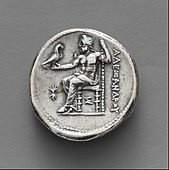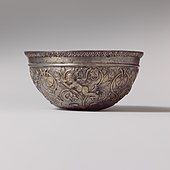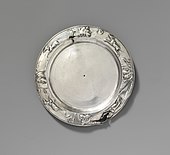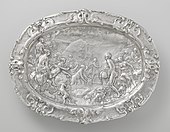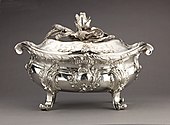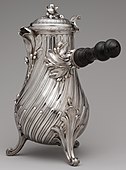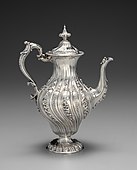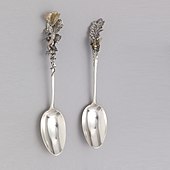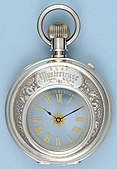Silver
 | ||||||||||||||||||||||||||||||||||||||||||||||||||||||||||
| Silver | ||||||||||||||||||||||||||||||||||||||||||||||||||||||||||
|---|---|---|---|---|---|---|---|---|---|---|---|---|---|---|---|---|---|---|---|---|---|---|---|---|---|---|---|---|---|---|---|---|---|---|---|---|---|---|---|---|---|---|---|---|---|---|---|---|---|---|---|---|---|---|---|---|---|---|
| Appearance | lustrous white metal | |||||||||||||||||||||||||||||||||||||||||||||||||||||||||
| Standard atomic weight Ar°(Ag) | ||||||||||||||||||||||||||||||||||||||||||||||||||||||||||
| Silver in the periodic table | ||||||||||||||||||||||||||||||||||||||||||||||||||||||||||
| ||||||||||||||||||||||||||||||||||||||||||||||||||||||||||
kJ/mol | ||||||||||||||||||||||||||||||||||||||||||||||||||||||||||
| Heat of vaporisation | 254 kJ/mol | |||||||||||||||||||||||||||||||||||||||||||||||||||||||||
| Molar heat capacity | 25.350 J/(mol·K) | |||||||||||||||||||||||||||||||||||||||||||||||||||||||||
Vapour pressure
| ||||||||||||||||||||||||||||||||||||||||||||||||||||||||||
| Atomic properties | ||||||||||||||||||||||||||||||||||||||||||||||||||||||||||
5000 BC | ||||||||||||||||||||||||||||||||||||||||||||||||||||||||||
| Symbol | "Ag": from Latin argentum | |||||||||||||||||||||||||||||||||||||||||||||||||||||||||
| Isotopes of silver | ||||||||||||||||||||||||||||||||||||||||||||||||||||||||||
| ||||||||||||||||||||||||||||||||||||||||||||||||||||||||||
Silver is a
Silver has long been valued as a
Other than in
Characteristics

Silver is similar in its physical and chemical properties to its two vertical neighbours in
Silver is a relatively soft and extremely
Silver has a brilliant, white, metallic luster that can take a high
Very high electrical and thermal conductivity are common to the elements in group 11, because their single s electron is free and does not interact with the filled d subshell, as such interactions (which occur in the preceding transition metals) lower electron mobility.
Silver readily forms
Isotopes
Naturally occurring silver is composed of two stable
Twenty-eight
Isotopes of silver range in
The palladium
Chemistry
| Oxidation state |
Coordination number |
Stereochemistry | Representative compound |
|---|---|---|---|
| 0 (d10s1) | 3 | Planar | Ag(CO)3 |
| 1 (d10) | 2 | Linear | [Ag(CN)2]− |
| 3 | Trigonal planar | AgI(PEt2Ar)2 | |
| 4 | Tetrahedral | [Ag(diars)2]+ | |
| 6 | Octahedral | AgF, AgCl, AgBr | |
| 2 (d9) | 4 | Square planar | [Ag(py)4]2+ |
| 3 (d8) | 4 | Square planar | [AgF4]− |
| 6 | Octahedral | [AgF6]3− |
Silver is a rather unreactive metal. This is because its filled 4d shell is not very effective in shielding the electrostatic forces of attraction from the nucleus to the outermost 5s electron, and hence silver is near the bottom of the
Most silver compounds have significant
Silver does not react with air, even at red heat, and thus was considered by
The three main forms of deterioration in historical silver artifacts are tarnishing, formation of silver chloride due to long-term immersion in salt water, as well as reaction with nitrate ions or oxygen. Fresh silver chloride is pale yellow, becoming purplish on exposure to light; it projects slightly from the surface of the artifact or coin. The precipitation of copper in ancient silver can be used to date artifacts, as copper is nearly always a constituent of silver alloys.[35]
Silver metal is attacked by strong oxidizers such as potassium permanganate (KMnO
4) and potassium dichromate (K
2Cr
2O
7), and in the presence of potassium bromide (KBr). These compounds are used in photography to bleach silver images, converting them to silver bromide that can either be fixed with thiosulfate or redeveloped to intensify the original image. Silver forms cyanide complexes (silver cyanide) that are soluble in water in the presence of an excess of cyanide ions. Silver cyanide solutions are used in electroplating of silver.[36]
The common
Compounds
Oxides and chalcogenides

Silver and gold have rather low
Halides
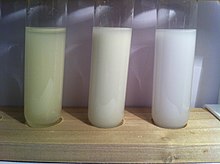
The only known dihalide of silver is the difluoride, AgF2, which can be obtained from the elements under heat. A strong yet thermally stable and therefore safe fluorinating agent, silver(II) fluoride is often used to synthesize hydrofluorocarbons.[41]
In stark contrast to this, all four silver(I) halides are known. The
- X− + hν → X + e− (excitation of the halide ion, which gives up its extra electron into the conduction band)
- Ag+ + e− → Ag (liberation of a silver ion, which gains an electron to become a silver atom)
The process is not reversible because the silver atom liberated is typically found at a
Other inorganic compounds
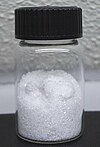
White
Yellow silver carbonate, Ag2CO3 can be easily prepared by reacting aqueous solutions of sodium carbonate with a deficiency of silver nitrate.[46] Its principal use is for the production of silver powder for use in microelectronics. It is reduced with formaldehyde, producing silver free of alkali metals:[47]
- Ag2CO3 + CH2O → 2 Ag + 2 CO2 + H2
Silver carbonate is also used as a
Silver fulminate, AgCNO, a powerful, touch-sensitive explosive used in percussion caps, is made by reaction of silver metal with nitric acid in the presence of ethanol. Other dangerously explosive silver compounds are silver azide, AgN3, formed by reaction of silver nitrate with sodium azide,[48] and silver acetylide, Ag2C2, formed when silver reacts with acetylene gas in ammonia solution.[31] In its most characteristic reaction, silver azide decomposes explosively, releasing nitrogen gas: given the photosensitivity of silver salts, this behaviour may be induced by shining a light on its crystals.[31]
- 2 AgN
3 (s) → 3 N
2 (g) + 2 Ag (s)
Coordination compounds
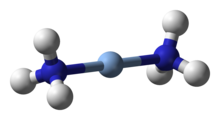
Silver complexes tend to be similar to those of its lighter homologue copper. Silver(III) complexes tend to be rare and very easily reduced to the more stable lower oxidation states, though they are slightly more stable than those of copper(III). For instance, the square planar periodate [Ag(IO5OH)2]5− and tellurate [Ag{TeO4(OH)2}2]5− complexes may be prepared by oxidising silver(I) with alkaline
Silver(II) complexes are more common. Like the valence isoelectronic copper(II) complexes, they are usually square planar and paramagnetic, which is increased by the greater field splitting for 4d electrons than for 3d electrons. Aqueous Ag2+, produced by oxidation of Ag+ by ozone, is a very strong oxidising agent, even in acidic solutions: it is stabilized in phosphoric acid due to complex formation. Peroxodisulfate oxidation is generally necessary to give the more stable complexes with heterocyclic amines, such as [Ag(py)4]2+ and [Ag(bipy)2]2+: these are stable provided the counterion cannot reduce the silver back to the +1 oxidation state. [AgF4]2− is also known in its violet barium salt, as are some silver(II) complexes with N- or O-donor ligands such as pyridine carboxylates.[49]
By far the most important oxidation state for silver in complexes is +1. The Ag+ cation is diamagnetic, like its homologues Cu+ and Au+, as all three have closed-shell electron configurations with no unpaired electrons: its complexes are colourless provided the ligands are not too easily polarized such as I−. Ag+ forms salts with most anions, but it is reluctant to coordinate to oxygen and thus most of these salts are insoluble in water: the exceptions are the nitrate, perchlorate, and fluoride. The tetracoordinate tetrahedral aqueous ion [Ag(H2O)4]+ is known, but the characteristic geometry for the Ag+ cation is 2-coordinate linear. For example, silver chloride dissolves readily in excess aqueous ammonia to form [Ag(NH3)2]+; silver salts are dissolved in photography due to the formation of the thiosulfate complex [Ag(S2O3)2]3−; and
Organometallic
Under standard conditions, silver does not form simple carbonyls, due to the weakness of the Ag–C bond. A few are known at very low temperatures around 6–15 K, such as the green, planar paramagnetic Ag(CO)3, which dimerizes at 25–30 K, probably by forming Ag–Ag bonds. Additionally, the silver carbonyl [Ag(CO)] [B(OTeF5)4] is known. Polymeric AgLX complexes with alkenes and alkynes are known, but their bonds are thermodynamically weaker than even those of the platinum complexes (though they are formed more readily than those of the analogous gold complexes): they are also quite unsymmetrical, showing the weak π bonding in group 11. Ag–C σ bonds may also be formed by silver(I), like copper(I) and gold(I), but the simple alkyls and aryls of silver(I) are even less stable than those of copper(I) (which tend to explode under ambient conditions). For example, poor thermal stability is reflected in the relative decomposition temperatures of AgMe (−50 °C) and CuMe (−15 °C) as well as those of PhAg (74 °C) and PhCu (100 °C).[51]
The C–Ag bond is stabilized by
Intermetallic

Silver forms
Most other binary alloys are of little use: for example, silver–gold alloys are too soft and silver–cadmium alloys too toxic. Ternary alloys have much greater importance: dental amalgams are usually silver–tin–mercury alloys, silver–copper–gold alloys are very important in jewellery (usually on the gold-rich side) and have a vast range of hardnesses and colours, silver–copper–zinc alloys are useful as low-melting brazing alloys, and silver–cadmium–indium (involving three adjacent elements on the periodic table) is useful in nuclear reactors because of its high thermal neutron capture cross-section, good conduction of heat, mechanical stability, and resistance to corrosion in hot water.[55]
Etymology
The word silver appears in
The chemical symbol Ag is from the
History

Silver was known in prehistoric times:[59] the three metals of group 11, copper, silver, and gold, occur in the elemental form in nature and were probably used as the first primitive forms of money as opposed to simple bartering.[60] However, unlike copper, silver did not lead to the growth of metallurgy on account of its low structural strength, and was more often used ornamentally or as money.[61] Since silver is more reactive than gold, supplies of native silver were much more limited than those of gold.[60] For example, silver was more expensive than gold in Egypt until around the fifteenth century BC:[62] the Egyptians are thought to have separated gold from silver by heating the metals with salt, and then reducing the silver chloride produced to the metal.[63]
The situation changed with the discovery of
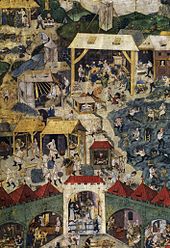
When the
Central Europe became the centre of silver production during the
With the discovery of America and the plundering of silver by the Spanish conquistadors, Central and South America became the dominant producers of silver until around the beginning of the 18th century, particularly Peru, Bolivia, Chile, and Argentina:[63] the last of these countries later took its name from that of the metal that composed so much of its mineral wealth.[65] The silver trade gave way to a global network of exchange. As one historian put it, silver "went round the world and made the world go round."[69] Much of this silver ended up in the hands of the Chinese. A Portuguese merchant in 1621 noted that silver "wanders throughout all the world... before flocking to China, where it remains as if at its natural center."[70] Still, much of it went to Spain, allowing Spanish rulers to pursue military and political ambitions in both Europe and the Americas. "New World mines", concluded several historians, "supported the Spanish empire."[71]
In the 19th century, primary production of silver moved to North America, particularly Canada, Mexico, and Nevada in the United States: some secondary production from lead and zinc ores also took place in Europe, and deposits in Siberia and the Russian Far East as well as in Australia were mined.[63] Poland emerged as an important producer during the 1970s after the discovery of copper deposits that were rich in silver, before the centre of production returned to the Americas the following decade. Today, Peru and Mexico are still among the primary silver producers, but the distribution of silver production around the world is quite balanced and about one-fifth of the silver supply comes from recycling instead of new production.[63]
-
Proto-Elamite kneeling bull holding a spouted vessel; 3100–2900 BC; 16.3×6.3×10.8 cm; Metropolitan Museum of Art(New York City)
-
Ancient Egyptian figurine of Horus as falcon god with an Egyptian crown; c. 500 BC; silver and electrum; height: 26.9 cm; Staatliche Sammlung für Ägyptische Kunst (Munich, Germany)
-
Ancient Greek tetradrachm; 315–308 BC; diameter: 2.7 cm; Metropolitan Museum of Art
-
Ancient Greek gilded bowl; 2nd–1st century BC; height: 7.6 cm, dimeter: 14.8 cm; Metropolitan Museum of Art
-
Roman plate; 1st–2nd century AD; height: 0.1 cm, diameter: 12.7 cm; Metropolitan Museum of Art
-
Roman bust of Serapis; 2nd century; 15.6×9.5 cm; Metropolitan Museum of Art
-
Auricular basin with scenes from the story of Diana and Actaeon; 1613; length: 50 cm, height: 6 cm, width: 40 cm; Rijksmuseum (Amsterdam, the Netherlands)
-
French Rococo tureen; 1749; height: 26.3 cm, width: 39 cm, depth: 24 cm; Metropolitan Museum of Art
-
French Rococo coffeepot; 1757; height: 29.5 cm; Metropolitan Museum of Art
-
French Neoclassical ewer; 1784–1785; height: 32.9 cm; Metropolitan Museum of Art
-
, US)
-
French Art Nouveau dessert spoons; circa 1890; Cooper Hewitt, Smithsonian Design Museum (New York City)
-
Art Nouveau jardinière; circa 1905–1910; height: 22 cm, width: 47 cm, depth: 22.5 cm; Cooper Hewitt, Smithsonian Design Museum
-
Mystery watch; ca. 1889; diameter: 5.4 cm, depth: 1.8 cm; Musée d'Horlogerie of Le Locle (Switzerland)
Symbolic role

Silver plays a certain role in mythology and has found various usage as a metaphor and in folklore. The Greek poet
But when good Saturn, banish'd from above,
Was driv'n to Hell, the world was underJove.
Succeeding times a silver age behold,
Excelling brass, but more excell'd by gold.— Ovid, Metamorphoses, Book I, trans. John Dryden
In folklore, silver was commonly thought to have mystic powers: for example, a
Silver production has also inspired figurative language. Clear references to cupellation occur throughout the Old Testament of the Bible, such as in Jeremiah's rebuke to Judah: "The bellows are burned, the lead is consumed of the fire; the founder melteth in vain: for the wicked are not plucked away. Reprobate silver shall men call them, because the Lord hath rejected them." (Jeremiah 6:19–20) Jeremiah was also aware of sheet silver, exemplifying the malleability and ductility of the metal: "Silver spread into plates is brought from Tarshish, and gold from Uphaz, the work of the workman, and of the hands of the founder: blue and purple is their clothing: they are all the work of cunning men." (Jeremiah 10:9)[62]
Silver also has more negative cultural meanings: the idiom thirty pieces of silver, referring to a reward for betrayal, references the bribe Judas Iscariot is said in the New Testament to have taken from Jewish leaders in Jerusalem to turn Jesus of Nazareth over to soldiers of the high priest Caiaphas.[77] Ethically, silver also symbolizes greed and degradation of consciousness; this is the negative aspect, the perverting of its value.[78]
Occurrence and production

The abundance of silver in the Earth's crust is 0.08
The principal sources of silver are the ores of copper, copper-nickel, lead, and lead-zinc obtained from
Silver is usually found in nature combined with other metals, or in minerals that contain silver compounds, generally in the form of
- Ag(s) + 2Pb(s) + O
2(g) → 2PbO(absorbed) + Ag(l)
Today, silver metal is primarily produced instead as a secondary byproduct of
Commercial-grade fine silver is at least 99.9% pure, and purities greater than 99.999% are available. In 2022, Mexico was the top producer of silver (6,300 tonnes or 24.2% of the world's total of 26,000 t), followed by China (3,600 t) and Peru (3,100 t).[88]
In marine environments
Silver concentration is low in seawater (pmol/L). Levels vary by depth and between water bodies. Dissolved silver concentrations range from 0.3 pmol/L in coastal surface waters to 22.8 pmol/L in pelagic deep waters.[89] Analyzing the presence and dynamics of silver in marine environments is difficult due to these particularly low concentrations and complex interactions in the environment.[90] Although a rare trace metal, concentrations are greatly impacted by fluvial, aeolian, atmospheric, and upwelling inputs, as well as anthropogenic inputs via discharge, waste disposal, and emissions from industrial companies.[91][92] Other internal processes such as decomposition of organic matter may be a source of dissolved silver in deeper waters, which feeds into some surface waters through upwelling and vertical mixing.[92]
In the Atlantic and Pacific, silver concentrations are minimal at the surface but rise in deeper waters.[93] Silver is taken up by plankton in the photic zone, remobilized with depth, and enriched in deep waters. Silver is transported from the Atlantic to the other oceanic water masses.[91] In North Pacific waters, silver is remobilized at a slower rate and increasingly enriched compared to deep Atlantic waters. Silver has increasing concentrations that follow the major oceanic conveyor belt that cycles water and nutrients from the North Atlantic to the South Atlantic to the North Pacific.[94]
There is not an extensive amount of data focused on how marine life is affected by silver despite the likely deleterious effects it could have on organisms through bioaccumulation, association with particulate matters, and sorption.[89] Not until about 1984 did scientists begin to understand the chemical characteristics of silver and the potential toxicity. In fact, mercury is the only other trace metal that surpasses the toxic effects of silver; however, the full extent of silver toxicity is not expected in oceanic conditions because of its ability to transfer into nonreactive biological compounds.[95]
In one study, the presence of excess ionic silver and silver nanoparticles caused bioaccumulation effects on zebrafish organs and altered the chemical pathways within their gills.[96] In addition, very early experimental studies demonstrated how the toxic effects of silver fluctuate with salinity and other parameters, as well as between life stages and different species such as finfish, molluscs, and crustaceans.[97] Another study found raised concentrations of silver in the muscles and liver of dolphins and whales, indicating pollution of this metal within recent decades. Silver is not an easy metal for an organism to eliminate and elevated concentrations can cause death.[98]
Monetary use
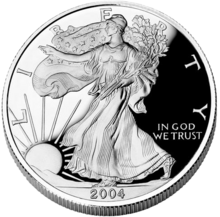
The earliest known coins were minted in the kingdom of Lydia in Asia Minor around 600 BC.[99] The coins of Lydia were made of electrum, which is a naturally occurring alloy of gold and silver, that was available within the territory of Lydia.[99] Since that time, silver standards, in which the standard economic unit of account is a fixed weight of silver, have been widespread throughout the world until the 20th century. Notable silver coins through the centuries include the Greek drachma,[100] the Roman denarius,[101] the Islamic dirham,[102] the karshapana from ancient India and rupee from the time of the Mughal Empire (grouped with copper and gold coins to create a trimetallic standard),[103] and the Spanish dollar.[104]
The ratio between the amount of silver used for coinage and that used for other purposes has fluctuated greatly over time; for example, in wartime, more silver tends to have been used for coinage to finance the war.[105]
Today, silver bullion has the ISO 4217 currency code XAG, one of only four precious metals to have one (the others being palladium, platinum, and gold).[106] Silver coins are produced from cast rods or ingots, rolled to the correct thickness, heat-treated, and then used to cut blanks from. These blanks are then milled and minted in a coining press; modern coining presses can produce 8000 silver coins per hour.[105]
Price

Silver prices are normally quoted in troy ounces. One troy ounce is equal to 31.1034768 grams. The London silver fix is published every working day at noon London time.[107] This price is determined by several major international banks and is used by London bullion market members for trading that day. Prices are most commonly shown as the United States dollar (USD), the Pound sterling (GBP), and the Euro (EUR).
Applications
Jewellery and silverware


The major use of silver besides coinage throughout most of history was in the manufacture of jewellery and other general-use items, and this continues to be a major use today. Examples include table silver for cutlery, for which silver is highly suited due to its antibacterial properties. Western concert flutes are usually plated with or made out of sterling silver;[109] in fact, most silverware is only silver-plated rather than made out of pure silver; the silver is normally put in place by electroplating. Silver-plated glass (as opposed to metal) is used for mirrors, vacuum flasks, and Christmas tree decorations.[110]
Because pure silver is very soft, most silver used for these purposes is alloyed with copper, with finenesses of 925/1000, 835/1000, and 800/1000 being common. One drawback is the easy tarnishing of silver in the presence of hydrogen sulfide and its derivatives. Including precious metals such as palladium, platinum, and gold gives resistance to tarnishing but is quite costly; base metals like zinc, cadmium, silicon, and germanium do not totally prevent corrosion and tend to affect the lustre and colour of the alloy. Electrolytically refined pure silver plating is effective at increasing resistance to tarnishing. The usual solutions for restoring the lustre of tarnished silver are dipping baths that reduce the silver sulfide surface to metallic silver, and cleaning off the layer of tarnish with a paste; the latter approach also has the welcome side effect of polishing the silver concurrently.[109]
Medicine
In medicine, silver is incorporated into wound dressings and used as an antibiotic coating in medical devices. Wound dressings containing
Electronics
Silver is very important in electronics for conductors and electrodes on account of its high electrical conductivity even when tarnished. Bulk silver and silver foils were used to make vacuum tubes, and continue to be used today in the manufacture of semiconductor devices, circuits, and their components. For example, silver is used in high quality connectors for
Brazing alloys
Silver-containing brazing alloys are used for brazing metallic materials, mostly cobalt, nickel, and copper-based alloys, tool steels, and precious metals. The basic components are silver and copper, with other elements selected according to the specific application desired: examples include zinc, tin, cadmium, palladium, manganese, and phosphorus. Silver provides increased workability and corrosion resistance during usage.[119]
Chemical equipment
Silver is useful in the manufacture of chemical equipment on account of its low chemical reactivity, high thermal conductivity, and being easily workable. Silver crucibles (alloyed with 0.15% nickel to avoid recrystallisation of the metal at red heat) are used for carrying out alkaline fusion. Copper and silver are also used when doing chemistry with fluorine. Equipment made to work at high temperatures is often silver-plated. Silver and its alloys with gold are used as wire or ring seals for oxygen compressors and vacuum equipment.[120]
Catalysis
Silver metal is a good catalyst for
Photography
Before the advent of digital photography, which is now dominant, the photosensitivity of silver halides was exploited for use in traditional film photography. The photosensitive emulsion used in black-and-white photography is a suspension of silver halide crystals in gelatin, possibly mixed in with some noble metal compounds for improved photosensitivity, developing, and tuning[clarify].
Colour photography requires the addition of special dye components and sensitisers, so that the initial black-and-white silver image couples with a different dye component. The original silver images are bleached off and the silver is then recovered and recycled. Silver nitrate is the starting material in all cases.[121]
The market for silver nitrate and silver halides for photography has rapidly declined with the rise of digital cameras. From the peak global demand for photographic silver in 1999 (267,000,000
Nanoparticles
Nanosilver particles, between 10 and 100 nanometres in size, are used in many applications. They are used in conductive inks for printed electronics, and have a much lower melting point than larger silver particles of micrometre size.[123] They are also used medicinally in antibacterials and antifungals in much the same way as larger silver particles.[114] In addition, according to the European Union Observatory for Nanomaterials (EUON), silver nanoparticles are used both in pigments, as well as cosmetics.[124][125]
Miscellanea
Pure silver metal is used as a food colouring. It has the E174 designation and is approved in the European Union.[126] Traditional Indian and Pakistani dishes sometimes include decorative silver foil known as vark,[127] and in various other cultures, silver dragée are used to decorate cakes, cookies, and other dessert items.[128]
The Texas Legislature designated silver the official precious metal of Texas in 2007.[129]
Precautions
| Hazards | |
|---|---|
| GHS labelling: | |

| |
| Warning | |
| H410 | |
| P273, P391, P501[130] | |
| NFPA 704 (fire diamond) | |
Silver compounds have low toxicity compared to those of most other
In large doses, silver and compounds containing it can be absorbed into the circulatory system and become deposited in various body tissues, leading to argyria, which results in a blue-grayish pigmentation of the skin, eyes, and mucous membranes. Argyria is rare, and so far as is known, does not otherwise harm a person's health, though it is disfiguring and usually permanent. Mild forms of argyria are sometimes mistaken for cyanosis, a blue tint on skin, caused by lack of oxygen.[131][12]
Metallic silver, like copper, is an antibacterial agent, which was known to the ancients and first scientifically investigated and named the oligodynamic effect by Carl Nägeli. Silver ions damage the metabolism of bacteria even at such low concentrations as 0.01–0.1 milligrams per litre; metallic silver has a similar effect due to the formation of silver oxide. This effect is lost in the presence of sulfur due to the extreme insolubility of silver sulfide.[131]
Some silver compounds are very explosive, such as the nitrogen compounds silver azide, silver amide, and silver fulminate, as well as silver acetylide, silver oxalate, and silver(II) oxide. They can explode on heating, force, drying, illumination, or sometimes spontaneously. To avoid the formation of such compounds, ammonia and acetylene should be kept away from silver equipment. Salts of silver with strongly oxidising acids such as silver chlorate and silver nitrate can explode on contact with materials that can be readily oxidised, such as organic compounds, sulfur and soot.[131]
See also
- Silver coin
- Silver medal
- Free silver
- List of countries by silver production
- List of silver compounds
- Silver as an investment
- Silverpoint drawing
References
- ^ "Standard Atomic Weights: Silver". CIAAW. 1985.
- ISSN 1365-3075.
- ^ ISBN 978-1-62708-155-9.
- .
- ISBN 0-8493-0486-5.
- ISBN 0-8493-0464-4.
- .
- ISBN 978-0-08-054523-3.
- ^ "Bullion vs. Numismatic Coins: Difference between Bullion and Numismatic Coins". providentmetals.com. Retrieved 17 December 2017.
- ^ "'World has 5 times more gold than silver' | Latest News & Updates at Daily News & Analysis". dna. 3 March 2009. Retrieved 17 December 2017.
- S2CID 58893669.
- ^ ISBN 978-0-8493-0485-9.
- ^ a b c d Greenwood and Earnshaw, p. 1177
- ^ a b Greenwood and Earnshaw, p. 1178
- ISBN 978-3-527-28126-8. Retrieved 2 May 2011.
- ISBN 978-1-60059-131-0.
- .
- ^ "Silver vs. Aluminum". Gemini Observatory. Retrieved 1 August 2014.
- ISBN 9780471649526.
- ISBN 978-0-688-06910-0.
- ^ Young, Howard (11 September 2002). "Eastman at Oak Ridge During World War II". Archived from the original on 8 February 2012.
- S2CID 22674885.
- ^ a b c d "Atomic Weights of the Elements 2007 (IUPAC)". Archived from the original on 6 September 2017. Retrieved 11 November 2009.
- ^ "Atomic Weights and Isotopic Compositions for All Elements (NIST)". Retrieved 11 November 2009.
- S2CID 120201972.
- ^
- ^ "Atomic Weights and Isotopic Compositions for Silver (NIST)". Retrieved 11 November 2009.
- .
- S2CID 120355895.
- ^ a b Greenwood and Earnshaw, p. 1179
- ^ a b c d e Greenwood and Earnshaw, p. 1180
- ^ Greenwood and Earnshaw, p. 1176
- ISBN 1-56700-065-7. p. 5
- ISBN 3-540-44376-2. p. 341
- ^ "Silver Artifacts" in Corrosion – Artifacts. NACE Resource Center
- ISBN 978-3-540-58619-7.
- .
- ^ a b Greenwood and Earnshaw, p. 1188
- ^ Greenwood and Earnshaw, p. 903
- ^ a b c Greenwood and Earnshaw, pp. 1181–82
- ^ a b c d e Greenwood and Earnshaw, pp. 1183–85
- ^ a b Greenwood and Earnshaw, pp. 1185–87
- . Retrieved 8 April 2022.
- ^ "Definition of Lunar Caustic". dictionary.die.net. Archived from the original on 31 January 2012.
- ^ Cope, A. C.; Bach, R. D. (1973). "trans-Cyclooctene". Organic Syntheses; Collected Volumes, vol. 5, p. 315.
- ^ a b McCloskey C.M.; Coleman, G.H. (1955). "β-d-Glucose-2,3,4,6-Tetraacetate". Organic Syntheses; Collected Volumes, vol. 3, p. 434.
- ^ Brumby et al.
- ISBN 978-3-527-31656-4.
- ^ Greenwood and Earnshaw, p. 1189
- ^ Greenwood and Earnshaw, pp. 1195–96
- ^ Greenwood and Earnshaw, pp. 1199–200
- .
- .
- .
- ^ a b Brumby et al., pp. 54–61
- ISBN 978-90-04-18340-7.
- ^ ISBN 978-0-19-928791-8.
- .
- ^ Weeks, p. 4
- ^ a b c Greenwood and Earnshaw, pp. 1173–74
- ISBN 978-1-61503-821-3.
- ^ a b c d e Weeks, pp. 14–19
- ^ a b c d e f g h Brumby et al., pp. 16–19
- ISBN 978-3944507057.
- ^ ISBN 978-0-19-960563-7.
- .
- S2CID 232346123.
- PMID 19805127.
- ISBN 0520214749.
- S2CID 154126073.
- JSTOR 20078638.
- S2CID 161808359.
- ISBN 978-1-85348-888-7.
- ISBN 978-954-304-232-6.
- ^ OCLC 936144129.
- S2CID 372277.
- ^ Matthew 26:15
- ISBN 978-973-46-1286-4.
- ^ a b Greenwood and Earnshaw, pp. 1174–67
- ^ Brumby et al., pp. 21–22
- ^ ISBN 978-0-9826741-4-7.
- ^ "Preliminary Economic Assessment Technical Report 43-101" (PDF). South American Silver Corp. Archived from the original (PDF) on 19 January 2012.
- ^ "Why Are Kyrgyzstan and Tajikistan So Split on Foreign Mining?". Eurasianet. EurasiaNet.org. 7 August 2013. Retrieved 19 August 2013.
- ^ Kassianidou, V. (2003). "Early Extraction of Silver from Complex Polymetallic Ores", pp. 198–206 in Craddock, P.T. and Lang, J (eds.) Mining and Metal production through the Ages. London, British Museum Press.
- ISBN 1560985356
- ^
Bayley, J., Crossley, D. and Ponting, M. (eds). (2008). [https://www.researchgate.net/publication/271133104_Metals_and_Metalworking_A_Research_Framework_for_Archaeometallurgy Metals and Metalworking. A research framework for archaeometallurgy. Historical Metallurgy Society. p. 6. ISBN 978-0-9560225-0-9
- ^ Pernicka, E., Rehren, Th., Schmitt-Strecker, S. (1998). "Late Uruk silver production by cupellation at Habuba Kabira, Syria", pp. 123–34 in Metallurgica Antiqua, Deutsches Bergbau-Museum.
- ^ a b Hilliard, Henry E. "Silver". USGS.
- ^ .
- .
- ^ .
- ^ .
- .
- .
- S2CID 129765758.
- S2CID 51719111.
- ^ Calabrese, A.; Thurberg, F.P.; Gould, E. (1977). "Effects of Cadmium, Mercury, and Silver on Marine Animals". Marine Fisheries Review. 39 (4): 5–11. Archived from the original on 26 January 2021.
- PMID 28442199.
- ^ a b "The origins of coinage". britishmuseum.org. Archived from the original on 2 May 2019. Retrieved 21 September 2015.
- ^ "Tetradrachm". Merriam-Webster. Retrieved 20 January 2008.
- ISBN 0-521-07492-4
- ^ Oxford English Dictionary, 1st edition, s.v. 'dirhem' Archived 9 February 2020 at the Wayback Machine
- ^ etymonline.com (20 September 2008). "Etymology of rupee". Retrieved 20 September 2008.
- ISBN 978-1-118-29217-4.
- ^ a b Brumby et al., pp. 63–65
- ^ "Current currency & funds code list – ISO Currency". SNV. Retrieved 29 March 2020.
- ^ "LBMA Silver Price". LBMA. Retrieved 29 March 2020.
- ^ Latka, Marcin. "Silver sarcophagus of Saint Stanislaus". artinpl. Retrieved 3 August 2019.
- ^ a b Brumby et al., pp. 65–67
- ^ a b Brumby et al. pp. 67–71
- PMID 21418360.
- S2CID 41051853.
- S2CID 27527124.
- ^ a b c Brumby et al., pp. 83–84
- ^
Panáček, Aleš; Kvítek, Libor; Smékalová, Monika; Večeřová, Renata; Kolář, Milan; Röderová, Magdalena; Dyčka, Filip; Šebela, Marek; Prucek, Robert; Tomanec, Ondřej; Zbořil, Radek (January 2018). "Bacterial resistance to silver nanoparticles and how to overcome it". Nature Nanotechnology. 13 (1): 65–71. S2CID 26783560.
- S2CID 30730306.
- S2CID 695256. Archived from the original(PDF) on 21 March 2016.
- ^ Brumby et al., pp. 71–78
- ^ Brumby et al., pp. 78–81
- ^ a b Brumby et al., pp. 81–82
- ^ Brumby et al., p. 82
- ^ "A Big Source of Silver Bullion Demand Has Disappeared". BullionVault. Retrieved 20 July 2014.
- ISSN 2075-4701.
- ^ "Pigments – ECHA". euon.echa.europa.eu.[permanent dead link]
- ^ "Catalogue of cosmetic ingredients – ECHA". euon.echa.europa.eu.[permanent dead link]
- PMID 23376782.
- ^ Sarvate, Sarita (4 April 2005). "Silver Coating". India Currents. Archived from the original on 14 February 2009. Retrieved 5 July 2009.
- ^ Meisler, Andy (18 December 2005). "A Tempest on a Tea Cart". Los Angeles Times.
- ISBN 9781625110664.
- ^ "Msds – 373249". Sigma Aldrich.
- ^ a b c d e Brumby et al., pp. 88–91
Cited sources
- Brumby, Andreas; et al. (2008). "Silver, Silver Compounds, and Silver Alloys". ISBN 978-3527306732.
- ISBN 978-0-08-037941-8.
- LCCN 68-15217.
External links
- Silver at The Periodic Table of Videos(University of Nottingham)
- The Silver Institute, industry associationwebsite
- Collection of silver items and samples from Theodore Gray
- Silver entry in the NIOSH Pocket Guide to Chemical Hazards published by the U.S. Centers for Disease Control and Prevention's National Institute for Occupational Safety and Health
- Silver prices - current commodities markets, from Bloomberg L.P.




